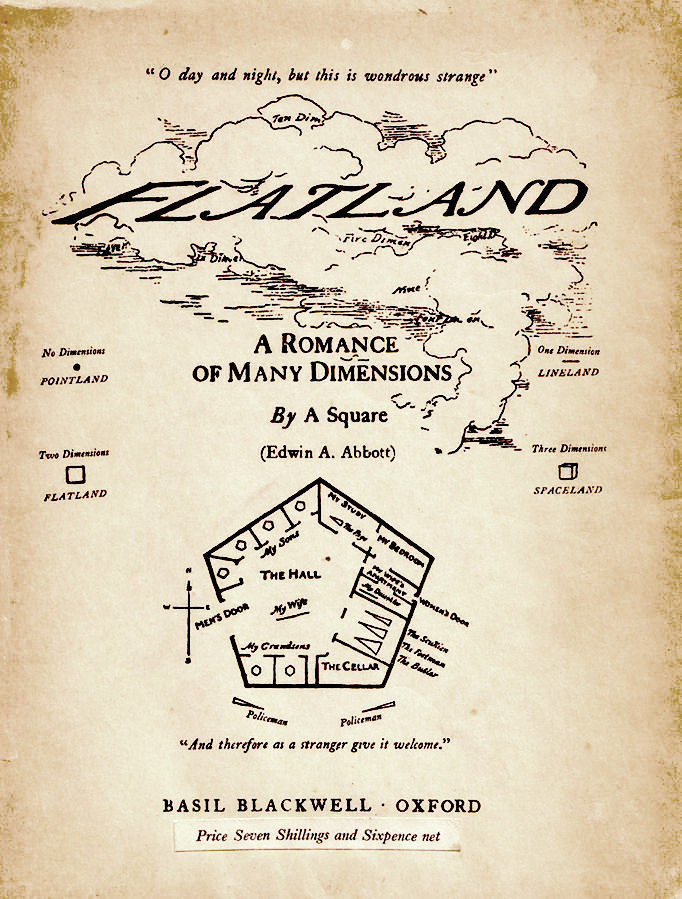 Can you imagine what it’d be like to live in two dimensions instead of three? Probably kind of. Of course, that imagination is contaminated with all kinds of three dimensional thinking, you still get the idea. How about four dimensions though? I’ll bet that’s almost impossible. It’s hard to imagine what four dimensions looks like. If you try to visualize it, you’ll probably just be visualizing something in three dimensions and making what you see into analogs for four dimensional concepts. Trying to imagine living in four dimensions kind of breaks our brain.
Can you imagine what it’d be like to live in two dimensions instead of three? Probably kind of. Of course, that imagination is contaminated with all kinds of three dimensional thinking, you still get the idea. How about four dimensions though? I’ll bet that’s almost impossible. It’s hard to imagine what four dimensions looks like. If you try to visualize it, you’ll probably just be visualizing something in three dimensions and making what you see into analogs for four dimensional concepts. Trying to imagine living in four dimensions kind of breaks our brain.
Exploring the weirdness of life in different dimensions is what Edwin A. Abbott did in his 1884 classic, Flatland.
Abbott was a schoolmaster, and his book wasn’t a huge hit when it was released. Its central themes at the time had to do more with social caste than science fiction. But Abbott, way ahead of his time, layered that commentary generously through a brain tickling book that wouldn’t really get people excited until Einstein’s general theory of relativity came along and got everybody in a tizzy about the fourth dimension.
The book’s main character, A Square, tells the story of life in Flatland, a two dimensional world where “up” means “north” and nothing else. In the form of a memoir, the Square unfolds his discovery of one, two, and finally three dimensional worlds, with the help of a Sphere who visits him from Spaceland.
The Square dedicates the first half of the book to helping the reader understand how life in flatland works. Physically speaking, he explains how they get around and how they recognize each other. Socially speaking, he lays out a bleak picture of a rigid caste system, analogous to the structure of Victorian England. In Flatland, all women are just straight lines between two points, and are just barely seen as rational beings. Men on the other hand have many sizes and shapes, the more sides and the more even the angles, the more noble. Very Irregular shapes are euthanized or relegated to the lowest classes. There’s virtually no social mobility, and the highest order in the land, the circles, conspire to drown out knowledge in order to keep their power.
Even from a distance, it’s not difficult to imagine the social commentary as it related to the Victorian hierarchy. It’s also not difficult to see the parallels with our modern society, where certain “shapes” are considered dangerous, criminal or useless at best. The layers pile on as The Square meets royalty from Pointland and Lineland, neither of which can conceive of anything greater than themselves. And, as the Sphere from Spaceland shows up, The Square himself cannot fathom what the Sphere is telling him until the Sphere brings him out of Flatland into Spaceland to see for himself.
Flatland is written in a style that, to modern readers, is either quirky and interesting, or dry and unnecessarily heady. Personally, I found it nostalgic. It reminded me of the works of 19th century church reformers who I used to spend a lot of time reading. The story is made up mostly of conversations between The Square and himself, and the Square and the Sphere. There are few narrative elements outside of that. However, the really fascinating thing is the thought process the reader must go through in order to connect with the Square’s character.
Flatland was a short read. You could probably finish it in a weekend. If you enjoy being forced to have strange and interesting thoughts, you won’t be disappointed with this one.

Recent Discussion